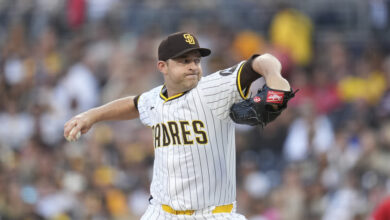
Tigers-Cubs Rewind: Breaking Down Javy’s Steal of Home
Against the Mets on June 3, Javier Baez electrified baseball with his steal of home. Essentially a high school-level play, it’s the element of surprise that proved key and helped break a 0-0 tie.
Cubs Insider detailed the live broadcast coverage of the play as called by Keith Hernandez and other announcers. Now flash forward one month to yesterday when Javy did it again. That element of surprise, however, is gone.
In fact, as soon as Addison Russell walked in the 4th inning, both Tigers and Cubs TV crews note Baez’s last steal of home. It’s the the exact same first-and-third situation with a lefty on the mound. Fox Sports Detroit even replayed that June steal shortly before his newest dash for home.
“You have to be careful if you are [Francisco] Liriano throwing the ball over to first base,” said Tigers color TV commentator Rod Allen. “You have to throw it firmly. Because Baez is so far down that line, and with his base-running instincts, he might just try to steal home plate. He’s that kind of baseball player.”
Unlike the Mets, the Tigers are ready. Cubs broadcaster Jim Deshaies notes Tigers corner man Jeimer Candelario is staying close to third base to shorten Baez’s lead. Compare this positioning to how the Mets were set up.
Not only is Candelario closer to third, but he even juke-steps toward Baez in an attempt to blunt some of the runner’s aggressiveness.
The odds grow longer against Baez when Liriano makes a firm pickoff throw to first, not the lob made by the Mets’ Steven Matz. Then, seeing Baez break for home, Tigers first baseman John Hicks instantly steps toward the pickoff throw and fires home.

Only two things allow for Baez’s successful steal. One, he executes a perfect swim move to elude the tag. But before this, Tigers catcher James McCann makes a small but decisive error in technique.
In the picture to the right, McCann is ready for Baez. Just as Liriano starts his pickoff, McCann looks at Baez at third. But when Baez breaks home, McCann sets up poorly for this foot race of inches.

To the left, see how McCann positions his left foot on the home-plate corner closest to first. The better starting point is 17 inches to his left on the corner closest to third base. This would maintain the required path to the plate for the runner while also allowing the catcher to quickly dip and turn in one motion to cut off most of the plate and slap on a tag.
In fact, the Tigers should have nailed Baez as the ball clearly beats him.

But McCann receives the ball positioned too far to the right and out front of the plate. He thus must reach back and dive at the head-first diving Baez. Because ball travels faster than body, it’s a precious loss of inches and hundredths of a second that proved the difference when Baez perfectly executes that swim move.
Notes Allen: “McCann probably could have let that ball travel a bit further. He could have caught it deeper.” See play again here.
Interestingly, this was not a good strategic play on Baez’s part. Joe Maddon always warns against “outcome bias” – just because something works (or doesn’t work), doesn’t mean it was the best percentage play. This applies here too, which WGN color announcer Jim Deshaies explains on air.
“I’m not a big fan of this play with nobody out. I think it’s a two-out play. Maybe a one-out play, depending on where you are in the batting order,” he says.
Now Deshaies wasn’t being negative, just pragmatic. And he was right. Runner on third, no outs. Pressure is high on the defense and pitcher with a hot Contreras up to bat. Plus, attempted steals of home are never high-percentage plays.
Acknowledging all this, the play does create an even higher degree of pressure on the average defense of a poor team like the Tigers. It requires perfect decision-making and execution by four players, including that third baseman holding Baez close.
Without a bit of surprise, though, none of the individual defensive elements needed to throw Baez out are exceptionally difficult. But like a perfect relay throw or 3-6-1 double play, the more moving pieces involved, the more chances for small mistakes on a bang-bang play. Also remember the Tigers had just muffed two previous chances to throw out an aggressive Baez at second and then third. So against a better team, Baez gets thrown out at home 95 percent of the time.
Moving forward, this play will have sustained value. It further reinforces the aggressive baserunning reputation of the Cubs (especially Baez). Opposing infielders will play a little tighter to bases to hold runners on, which will further open hitting lanes. Pitchers will be more preoccupied in the stretch and less-than-sterling fielders will tighten up a tad more before trying to nail Baez on a throw.
Plus, for future first-and-third situations with Baez on third, teams very well could concede a steal of second to not risk Baez stealing home on the long throw. But for now, let’s give Allen the last word:
“When was the last time you saw a player steal home plate? It just doesn’t happen that often. That’s why I am really fond of Baez as a player. Yes, we watched him strike out three times [yesterday], but [today] he got a base hit, stole second, got to third, and the man stole home plate.” (Emphasis his.)
For previous “Rewind” articles, click here.

